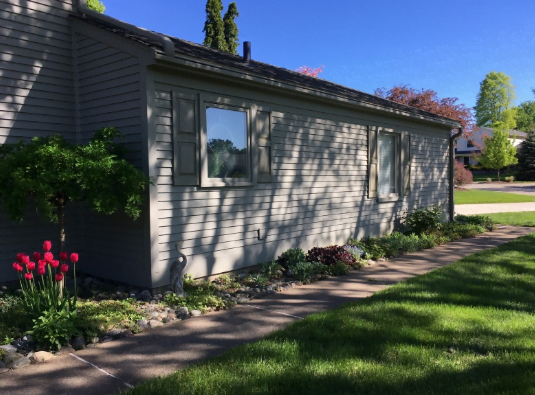
Prep your lawn in SE Michigan for spring by getting your grass seed down at the right time of year.
1. Test the soil pH levels.
Seeding your yard is the easiest thing for a homeowner to do. Use a soil testing kit to determine the pH levels of your lawn. Different types of grasses thrive at different pH levels. You’ll need to till the soil to a depth of 3 to 4 inches. This will break up the clumps and give the roots of the grass seedlings plenty of room to spread.
2. Choose the right grass seed.
Once you know the pH level of your soil, choose the right type of grass seed for your lawn
3. Prepare the soil.
Loosen the soil in the area you are seeding by raking it. Remove any existing weeds or rocks.
4. Spread the seed.
Choose a grass-seed blend that’s appropriate for your climate and spread it evenly over the soil. You’ll want to err on the side of more rather than less – grass seed is cheap, and it’ll be worth it in the long run. Spread the grass seed evenly over the area. Now add a general-purpose fertilizer to the soil. Opt for one that’s slow release, which will nourish your grass for several weeks or months, rather than a single application.
5. Cover the seed.
Use a thin layer of soil, compost, or mulch to cover the seed. Lightly rake the seed in and then cover it with a thin layer of compost or soil. This will help protect the seed from birds and other animals
6. Water the lawn.
Water the lawn thoroughly and ensure the soil remains damp while the grass is growing.
7. Mow the lawn.
Once the grass has grown to a height of 3-4 inches, mow it to the desired length. Now you’ll want to water the soil regularly. Keep it moist but not soggy. This is essential for successful germination.
Step 1 Seeding Overview
Seeding a lawn is an essential part of lawn maintenance. Seeding a lawn will help thicken the existing turf and keep the lawn looking lush and healthy. It is important to understand the basics of how to seed a lawn before beginning the process.
Step 2 Choose the Right Seed
When choosing a seed, it is important to select the right type for your climate and soil conditions. Research the types of grasses that grow best in your area and select the right mix of seeds that will thrive in your lawn.
Step 3 Prepare the Soil
Before seeding, it is important to prepare the soil. This will ensure that the seed can take root and grow. Remove any weeds, clumps of grass, and debris from the area. Then, loosen the soil and make sure it is free from compaction.
Step 4 Spread the Seed
Once the soil has been prepared, spread the seed evenly across the entire lawn. Make sure the seed is spread evenly and follow the recommended seeding rate for the type of grass you are using.
Rake in the Grass Seed
1. Start by using a rake to loosen the top layer of soil in the area you want to seed. This will help the grass seed make contact with the soil, which will promote germination.
2. Spread the seed. Use a push-type or handheld seed spreader to spread the seed evenly over the area. Spread the seed in two directions—north-south and east-west. This will ensure even coverage.
3. Cover the seed. To ensure the seed makes contact with the soil, you will need to lightly rake the area and cover the seed with a thin layer of soil or peat moss. Avoid covering the seed with more than ¼ inch of soil.
4. Water the area. Water the seeded area twice a day for the first two weeks. After two weeks, water the seed every other day for the next two weeks. After that, water the lawn as needed.
Remove Rocks and Roots
1. Remove all rocks, large roots, and other debris from the lawn area. Use a steel rake to pull out large rocks and roots.
2. Till the soil to a depth of several inches. This will help break up the soil and allow the seed to make good contact with the soil.
3. Apply a starter fertilizer to the soil. This will help the seed germinate and grow.
4. Spread the grass seed evenly over the lawn area, using a seed spreader if necessary.
5. Rake the lawn area lightly to help the seed make good contact with the soil.
6. Water the lawn area thoroughly. Keep the soil moist for the next few weeks.
7. Mow the lawn when the grass is about 3 inches tall.
Water Regularly
Make sure to water the lawn regularly, especially during hot weather.
1. Water the lawn regularly, especially during hot weather.
2. Fertilize the lawn after it is established.
3. Set the mower blade to a height of 2 1/2 to 3 inches.
4. Aerate the lawn once a year.
5. Overseed the lawn to keep it healthy.
6. Top-dress the lawn with a thin layer of material.
7. Mulch around the lawn to retain moisture.

